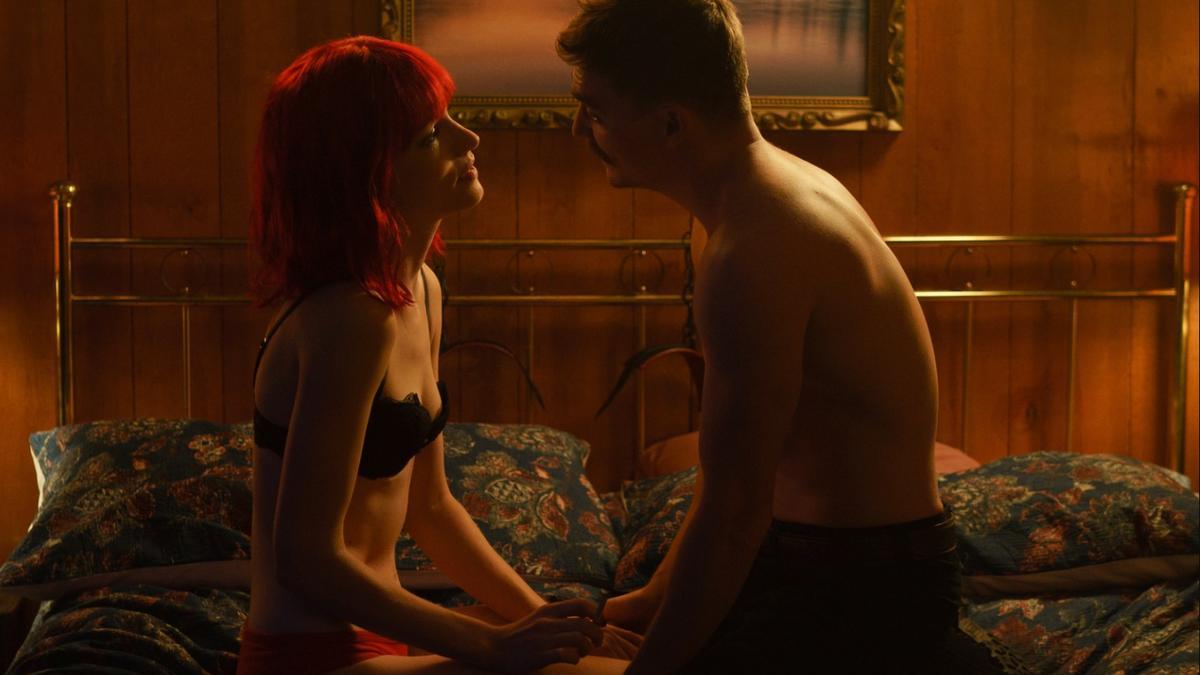
In a bold cinematic move, writer-director JT Mollner invites audiences to delve into the murky depths of his latest offering, ‘Strange Darling’. Seamlessly blending the psychosexual tension of Alfred Hitchcock’s work with the surreal aesthetics reminiscent of David Lynch, Mollner forges a distinctive homage to grindhouse horror. Yet, this film isn’t content with adhering to genre norms; instead, it crafts an audacious narrative that subverts both conventions and audience expectations, presenting a labyrinthine tale that’s far from the typical slasher fare.
The story launches with a bang, abandoning slow-burn suspense in favor of an adrenaline-pumping chase through a sprawling mid-western field. The scene is drenched in the haunting strains of Nazareth’s ‘Love Hurts’ as Willa Fitzgerald, playing the enigmatic character known only as “The Lady”, flees in slow-motion, her body bloodied and desperate. These initial moments evoke memories of ‘The Texas Chainsaw Massacre’, yet the dreamlike quality of the cinematography aligns it more closely with modern-day cult classics like ‘Mandy’. Mollner wastes no time in thrusting viewers into the midst of the action, propelling them straight into the third of six chapters in his non-linear storyline. Temporal coherence is dismissed, instead fostering an atmosphere where tension is perpetually high, with plot revelations delivered in abrupt and unexpected turns.
From its outset, ‘Strange Darling’ pulsates with an ever-present sense of anxiety. The narrative focuses on two principal figures — The Lady and her relentless pursuer, “The Demon” (Kyle Gallner). Their interactions oscillate between harrowing terror and fleeting moments of uneasy respite. Initially, The Lady appears as a beleaguered victim, navigating a desperate flight for survival. However, Mollner’s direction ensures no character is easily pigeonholed into clear victim-or-villain roles. Both Fitzgerald and Gallner’s performances are central to this subversion. Fitzgerald adeptly intertwines vulnerability with an undercurrent of menace, while Gallner contrasts his small-town charm with an ominous malevolence.
Much of the film’s edge is derived from its meticulous visual and auditory elements. Shot on 35mm film, a stylistic choice proudly announced at the outset by cinematographer Giovanni Ribisi, the movie exudes a retro aura through its grainy texture, which imbues every frame with a persistent eeriness. The camera’s gaze alternates between expansive landscapes and claustrophobic close-ups, rendering both scenescapes fraught with latent danger. The color palette, particularly the pervasive use of red, serves as a dual symbol of passion and violence.
.
However, the sound design does not achieve the same level of precision. While the intent appears to be fostering disorientation and deepening the mystery, it often results in mumbled early scenes that obscure dialogue rather than enrich the experience. This misstep feels more like a technical shortfall than an intentional artistic maneuver.
A key distinguishing feature of ‘Strange Darling’ is its deliberate toying with audience expectations. Mollner keenly exploits ingrained perceptions about gender roles within crime and horror genres, repeatedly overturning these assumptions to keep viewers on edge. The narrative playfully sows seeds of supposed certainty only to upend them at critical junctures, keeping viewers constantly questioning. Yet, as the layers of misdirection accumulate, there is a risk of diminishing returns. The plot’s ultimate twist, while initially riveting, may lose some of its potency once fully laid bare, causing a slight sag in the narrative drive.
Moreover, Mollner’s penchant for shock value occasionally brushes up against the limits of taste and necessity. The Lady endures extensive physical and emotional trials throughout the film, and while genre aficionados might appreciate the discomfort this engenders, the unrelenting brutality can begin to feel excessive. One later development involving a female police officer introduces a sequence of unfortunate mishaps that mire the film in potentially problematic misogynistic undertones.
Despite these pitfalls, ‘Strange Darling’ is an undeniably stylish venture, especially appealing to connoisseurs of genre cinema that indulges in artifice and discomfort. The film boasts a strong aesthetic sensibility; from its rich, evocative lighting to its intricate editing, Mollner’s directorial confidence is evident in every frame. He manipulates mood masterfully, weaving a sustained ambiance of oppressive dread and twisted seduction that lingers well beyond the closing credits.
In the final analysis, ‘Strange Darling’ emerges as one of the year’s most daring cinematic experiences. It’s not without its flaws – beneath the spectacle, one might question if the plot’s substance matches its ambitious presentation. Nevertheless, in a sea of formulaic horror offerings, ‘Strange Darling’ dares to be different, etching a lasting impression through its bold, albeit occasionally self-indulgent, narrative choices.
‘Strange Darling’ is currently captivating audiences in theaters.












